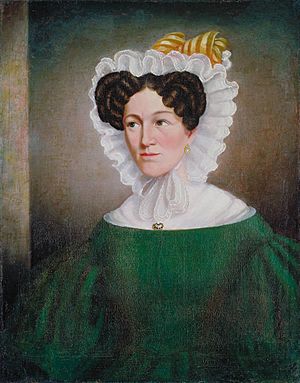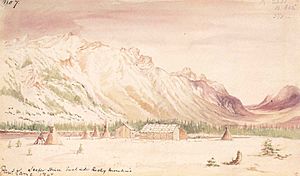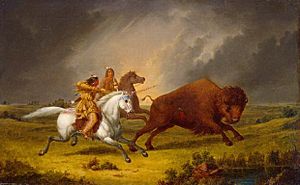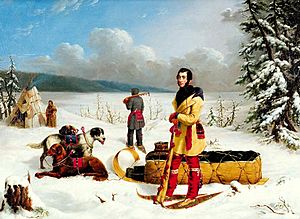Paul Kane facts for kids
Quick facts for kids
Paul Kane
|
|
|---|---|
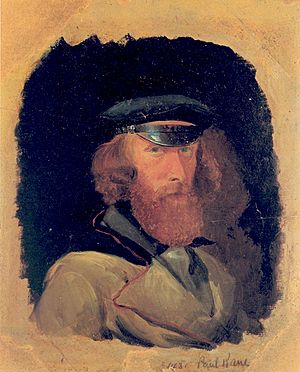
Self-portrait, circa 1845
|
|
| Born | September 3, 1810 |
| Died | February 20, 1871 (aged 60) |
| Nationality | Irish-Canadian |
| Education | Self-educated |
| Known for | Painter |
| Spouse(s) | Harriet Clench (m. 1853) |
Paul Kane (born September 3, 1810 – died February 20, 1871) was an Irish-born Canadian painter. He is famous for his paintings of First Nations people in Western Canada and other Native Americans in the Columbia District.
Paul Kane was mostly self-taught as an artist. He grew up in York, Upper Canada (which is now Toronto). He learned to paint by copying works from famous European artists during a study trip called a "Grand Tour" in Europe. He made two big trips across the Canadian northwest. The first was in 1845, from Toronto to Sault Ste. Marie and back. The second, much longer trip, was from 1846 to 1848. For this journey, he got help from the Hudson's Bay Company. He traveled from Toronto, across the Rocky Mountains, all the way to Fort Vancouver (now in Vancouver, Washington) and Fort Victoria (now Victoria, British Columbia).
During both trips, Kane drew and painted First Nations and Métis people. When he returned to Toronto, he created over one hundred oil paintings based on these sketches. These oil paintings are now seen as an important part of Canadian history. However, Kane often added dramatic details to them, making them less accurate than his original field sketches. Kane's work aimed to record cultures that he believed were disappearing.
Contents
Early Life and Art Training
Kane was born in Mallow, County Cork, Ireland. He was the fifth of eight children born to Michael Kane and Frances Loach. His father was a soldier who settled in Ireland after leaving the army in 1801. Between 1819 and 1822, when Paul was about ten, his family moved to Upper Canada and settled in York (now Toronto). There, Kane's father ran a shop selling drinks like spirits and wine.
We don't know much about Kane's early life in York. At that time, York was a small town with only a few thousand people. He went to Upper Canada College. Around 1830, he also got some painting lessons from an art teacher named Thomas Drury at the college. In July 1834, he showed some of his paintings in Toronto's first (and only) art show by The Society of Artists and Amateurs. A local newspaper, The Patriot, gave him a good review.
Kane started his career painting signs and furniture in York. Then, in 1834, he moved to Cobourg, Ontario. He might have worked in a furniture factory owned by Freeman Schermerhorn Clench. Freeman's daughter, Harriet Clench, later became Kane's wife in 1853. While in Cobourg, Kane painted several portraits of local people, including the sheriff and his boss's wife. In 1836, Kane moved to Detroit, Michigan. There, he met James Bowman, an American artist he had known in York. Bowman convinced Kane that studying art in Europe was important for a painter. They planned to travel to Europe together. But Kane had to delay his trip because he didn't have enough money. Bowman also got married and didn't want to leave his family. For the next five years, Kane traveled around the Midwestern United States. He worked as a traveling portrait painter, even going as far as New Orleans.
In June 1841, Kane left America. He sailed from New Orleans to Marseille in France, arriving about three months later. From there, he immediately went to Italy. Kane walked a lot of this journey, traveling on foot from Rome to Naples. He also crossed the Brenner Pass in Switzerland. He then went to Paris and later London. In London, he might have met George Catlin. Catlin was an American painter who focused on Native Americans on the prairies. Catlin was promoting his book, Letters and Notes on the Manners, Customs and Conditions of the North American Indians. Catlin gave talks and showed some of his paintings at Egyptian Hall in Piccadilly. In his book, Catlin said that Native American cultures were disappearing. He believed they should be recorded before they were gone forever. Kane found this idea very powerful. He decided to do the same for Canadian First Nations.
Kane returned to Mobile, Alabama, in early 1843. He set up a studio there and worked as a portrait painter. He kept painting until he had paid back the money he borrowed for his trip to Europe. He came back to Toronto in late 1844 or early 1845. Right away, he started getting ready for his journey west.
Adventures in the Northwest
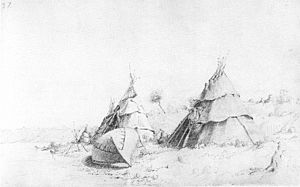
Kane began his first solo trip on June 17, 1845. He traveled along the northern shores of Lake Huron, passing through Saugeen land. After weeks of sketching, he reached Sault Ste. Marie (between Lake Superior and Lake Huron) in the summer of 1845. He had planned to go further west. However, John Ballenden, a manager for the Hudson's Bay Company there, warned him. He said it was very hard and dangerous to travel alone in the western lands. Ballenden advised Kane to only try such a trip with the company's help. The Hudson's Bay Company had taken over another company in 1821. This meant they controlled all the land west of the Great Lakes to the Pacific Ocean. They had about a hundred isolated trading posts along the main fur trade routes. Kane went back to Toronto for the winter. He turned his field sketches into oil paintings. In the spring of the next year, he went to the Hudson's Bay Company's main office in Lachine. He asked the company's governor, George Simpson, for help with his travel plans. Simpson was impressed by Kane's art and by letters from Ballenden and John Henry Lefroy. But he worried Kane might not be strong enough to travel with the company's fur brigades (groups of canoes carrying furs). So, he allowed Kane to travel in company canoes only as far as Lake Winnipeg. He promised full passage if Kane did well until then. Kane would travel on Hudson's Bay Company routes with their full support for the next two years. He did much of his sketching at their trading posts.
Journeying West
On May 9, 1846, Kane left Toronto by steamboat. He planned to meet a canoe group from Lachine at Sault Ste. Marie. After an overnight stop, he missed the boat because it left earlier than he was told. He had to chase after it by canoe. When he arrived at Sault Ste. Marie, he learned the canoe group had already left. So, he sailed on a freight schooner to Fort William on Thunder Bay. He finally caught up with the canoes about 35 miles (56 km) past Fort William on the Kaministiquia River on May 24.
By June 4, Kane reached Fort Frances. A special pass from Governor Simpson was waiting for him there, allowing him to travel further. His next stop was the Red River Colony (near modern-day Winnipeg). From there, he went on a three-week horse trip. He joined a large group of Métis hunters who were hunting buffalo in Sioux lands in the United States. On June 26, Kane saw and took part in one of the last great buffalo hunts. Within a few decades, with the help of railroad travel, these animals were almost wiped out. After returning, he continued by canoe and sailing boats. He went through Norway House, Grand Rapids, and The Pas. Then he traveled up the Saskatchewan River to Fort Carlton. For a change, he continued from there on horseback to Fort Edmonton. Along the way, he saw a Cree buffalo pound hunt.
On October 6, 1846, Kane left Edmonton for Fort Assiniboine. There, he again joined a canoe group. They went up the Athabasca River to Jasper's House, arriving on November 3. Here, he joined a large group traveling west by horse. But the group soon had to send the horses back to Jasper's House. They continued on snowshoes, taking only what was essential. This was because Athabasca Pass already had too much snow that late in the year. They crossed the pass on November 12. Three days later, they joined a canoe group that had been waiting to take them down the Columbia River.
In the Oregon Country
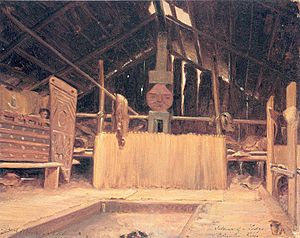
Finally, Kane arrived on December 18, 1846, at Fort Vancouver. This was the main trading post and headquarters of the Hudson's Bay Company in the Oregon Territory. He stayed there over the winter. He sketched and studied the Chinookan and other tribes nearby. He also made several trips, including a three-week journey through the Willamette Valley. He enjoyed the social life at Fort Vancouver. The British ship Modeste was visiting at that time, and Kane became friends with Peter Skene Ogden.
On March 25, 1847, Kane set out by canoe for Fort Victoria. This fort had been built recently to be the new company headquarters. Operations at Fort Vancouver were being moved because of the Oregon Treaty of 1846. This treaty set the border between Canada and the United States west of the Rocky Mountains at the 49th parallel north. Kane went up the Cowlitz River and stayed for a week among the tribes living near Mount St. Helens. Then he continued on horseback to Nisqually (today Tacoma). From there, he traveled by canoe again to Fort Victoria.
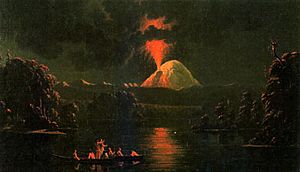
His painting of Mount St. Helens erupting at night in 1847 is now in the Royal Ontario Museum in Toronto. It was the only known image of an active volcano in the Cascade Mountains until Lassen Peak erupted in California in 1914. Even though the scene was a bit made-up, it correctly showed the active vent on the side of the volcano, not the top. He stayed for two months in that area. He traveled and sketched among the Native Americans on Vancouver Island and around the Strait of Juan de Fuca and the Strait of Georgia. He returned to Fort Vancouver in mid-June. From there, he left to go back east on July 1, 1847.
Crossing the Rockies Again
By mid-July, Kane had reached Fort Walla Walla. He made a small detour to visit the Whitman Mission. A few months later, this mission would be the site of a very sad event, the Whitman massacre. He went with Marcus Whitman to visit the Cayuse living in the area. He happened to draw a portrait of Tomahas (Kane called him "To-ma-kus"). This man would later be named as Whitman's murderer. According to Kane's travel report, the relationship between the Cayuse and the settlers at the mission was already tense when he visited in July.
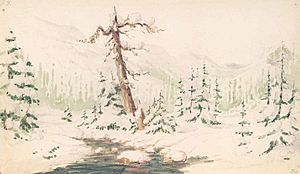
Kane continued with one guide by horseback through the Grand Coulee to Fort Colvile. He stayed there for six weeks, sketching and painting the local people. They had set up a fishing camp below Kettle Falls during the salmon run. On September 22, 1847, Kane took charge of a canoe group going up the Columbia River. They arrived on October 10 at Boat Encampment. The group had to wait for three weeks for a very late horse team from Jasper. Then they switched. The horse team took the canoes down the Columbia River. Kane's group loaded their cargo onto the horses and took them back over Athabasca Pass. They managed to bring all 56 horses safely to Jasper's House, even with heavy snow and intense cold. The canoes that should have been waiting for them had already left. So, they had to set out on snowshoes with a dog sled to Fort Assiniboine. They arrived there two weeks later, after much difficulty and without food. After a few days' rest, they continued to Fort Edmonton, where they spent the winter.
Kane spent his time at the fort hunting buffalo. He also sketched among the Cree people living nearby. In January, he took a trip to Fort Pitt, about 200 miles (320 km) down the Saskatchewan River. Then he returned to Edmonton. In April, he visited Rocky Mountain House. He wanted to meet the Blackfoot people there. When they didn't show up, he went back to Edmonton.
Returning East

On May 25, 1848, Kane left Fort Edmonton. He traveled with a large group of 23 boats and 130 people heading for York Factory. The group was led by John Edward Harriott. On June 1, they met a large group of about 1,500 warriors from the Blackfoot and other tribes. They were planning a raid against the Cree and Assiniboine people. On that day, Kane met the Blackfoot chief Big Snake (Omoxesisixany). The canoe group stayed as briefly as possible and then quickly continued down the river. On June 18, they arrived at Norway House. Kane stayed there for a month, waiting for the yearly meeting of the Hudson's Bay Company's chief managers. He also waited for the group he was supposed to travel with next. On July 24, he left with Major McKenzie's group. They traveled along the eastern shore of Lake Winnipeg to Fort Alexander. From there, Kane followed the same route he had taken two years earlier when going west. He traveled by canoe through the Lake of the Woods, Fort Frances, and Rainy Lake to Fort William. Then he went along the northern shore of Lake Superior until he reached Sault Ste. Marie on October 1, 1848. From there, he returned by steamboat to Toronto, arriving on October 13. He wrote in his book about this last part of his journey: "the greatest hardship that I had to endure [now] was the difficulty in trying to sleep in a civilized bed."
Life in Toronto and Later Years
Kane settled permanently in Toronto. He went west one more time in 1849. A British group hired him as a guide and interpreter, but they only went as far as the Red River Colony. In November 1848, an exhibition of 240 of his sketches in Toronto was very successful. A second exhibition in September 1852, showing eight oil paintings, was also well-received. A politician named George William Allan noticed Kane's work. Allan became his most important supporter. In 1852, he ordered one hundred oil paintings for $20,000. This allowed Kane to live as a full-time artist. In 1851, Kane also convinced the Parliament of the Province of Canada to order twelve paintings for £500. He delivered these paintings in late 1856.
In 1853, Kane married Harriet Clench (1823–1892). She was the daughter of his former employer in Cobourg. David Wilson, a historian from the University of Toronto, said that she was also a skilled painter and writer. They had four children: two sons and two daughters.
By 1857, Kane had finished his big painting orders. He completed over 120 oil paintings for Allan, the Parliament, and Simpson. His works were shown at the World's Fair in Paris in 1855. They received very good reviews there. Some of his paintings were even sent to Buckingham Palace in 1858 for Queen Victoria to see.
Around that time, Kane also wrote a book based on his travel notes. He sent it to a publisher in London. When he didn't hear back, he traveled to London. With help from Simpson, the book was published the next year. It was called The Wanderings of an Artist among the Indians of North America from Canada to Vancouver's Island and Oregon through the Hudson's Bay Company's Territory and Back Again. It was first published in London in 1859. The book included many lithographs (prints) of his sketches and paintings. Kane dedicated the book to Allan, which upset Simpson. Simpson then stopped his friendship with Kane. The book was an immediate success. By 1863, it had been translated into French, Danish, and German.
Kane's eyesight got worse quickly in the 1860s. This forced him to stop painting completely. Frederick Arthur Verner, an artist who painted "western" scenes and was inspired by Kane, became a friend. Verner painted three portraits of the older Paul Kane. One of these is now at the Royal Ontario Museum. Kane died unexpectedly one winter morning at his home, right after returning from his daily walk. He is buried at the St. James Cemetery in Toronto.
His Artworks
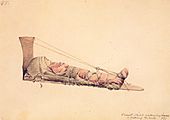 |
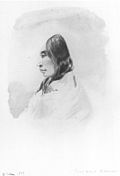 |
| Two field sketches by Kane Click images for larger views |
|
Most of Kane's art includes over 700 sketches he made during his two trips to the west. He also created more than one hundred oil paintings from these sketches in his Toronto studio. His early portraits from York or Cobourg, before his travels, are simple but have a direct charm and warm colors. He also made an unknown number of paintings when he was a traveling portrait painter in the United States. Plus, he copied many classic paintings while in Europe.
Kane is famous for his paintings of Native American life. He made his field sketches using pencil, watercolor, or oil on paper. He also brought back a collection of items from his trips, like masks, pipe stems, and other crafts. These items and sketches were the basis for his later studio work. He used these ideas for his large oil paintings. In these, he often combined or changed his sketches to create new scenes. The field sketches are very helpful for people who study cultures. However, the oil paintings, while showing true details of Native American life, often changed the real places, times, or cultural settings in their overall pictures.
One famous example is Kane's painting Flathead woman and child. In this painting, he combined a sketch of a Chinookan baby whose head was being flattened by being tied to a cradle board. He combined this with a later portrait of a Cowlitz woman who lived in a different area. Another example of how Kane changed his sketches is his painting Indian encampment on Lake Huron. This painting is based on a sketch he made in the summer of 1845 during his first trip to Sault Ste. Marie. The painting has a strong romantic feeling, with special lighting and dramatic clouds. The scene of camp life looks like an ideal European countryside picture.
Kane often created completely made-up scenes for his oil paintings by combining several sketches. His oil painting of Mount St. Helens erupting shows a huge and dramatic volcanic eruption. But from his travel diary and field sketches, we know the mountain was only gently smoking when Kane visited. (It had erupted three years earlier, though.) In other paintings, he combined river sketches taken at different times and places into one painting. This created a landscape that doesn't exist in real life. His painting of The Death of Big Snake shows a completely imaginary scene. The Blackfoot chief Omoxesisixany actually died in 1858, more than two years after the painting was finished.
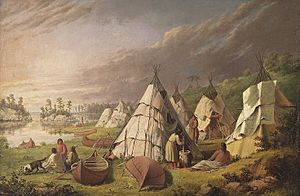
Kane's style was influenced by classic European paintings. But he also had practical reasons for painting his oil works in the more formal style of European art. He wanted to sell his paintings to make a living, and he knew what his customers liked. His patrons probably wouldn't want plain copies of his field sketches in their homes. They wanted something more impressive and closer to the European art styles popular at the time.
Kane's changes are clear in his painting Assiniboine hunting buffalo. This was one of the twelve paintings he did for the parliament. The painting has been criticized because the horses look more like Arabian horses than horses found in the Canadian West. Some even think the way the painting is arranged is based on an Italian picture from 1816 showing two Romans hunting a bull. As early as 1877, Nicholas Flood Davin pointed out this difference. He said that "the Indian horses are Greek horses, the hills have much of the colour and form of those of [...] the early European landscape painters." Lawrence Johnstone Burpee added in 1925 that the sketches were "truer interpretations of the wild western life" and had "in some respects a higher value as art."
Art experts today are less critical than Burpee. But they agree that Kane's field sketches are generally more accurate and real. "Kane was the recorder in the field and the artist in the studio," wrote Davis and Thacker.
Kane is seen as a classic and one of the most important Canadian painters. The eleven paintings he did for the parliament that still exist (one was lost in a fire on Parliament Hill in 1916) were moved to the National Gallery of Canada in 1955. The large collection owned by Allan was bought by Edmund Boyd Osler in 1903. He donated it to the Royal Ontario Museum in Toronto in 1912. A collection of 229 sketches was sold by Kane's grandson, Paul Kane III, for about US$100,000 to the Stark Museum of Art in Orange, Texas, in 1957.
A rare painting by Kane, Scene in the Northwest: Portrait of John Henry Lefroy, shows the British surveyor John Henry Lefroy. This painting had been owned by the Lefroy family in England. It sold for a record price at an auction in Toronto on February 25, 2002. Canadian billionaire Kenneth Thomson bought it for C$5,062,500 (about US$3,172,567.50 at the time). Thomson later donated the painting to the Art Gallery of Ontario as part of his collection. The Glenbow Museum in Calgary has a copy of this painting. It is thought to have been painted by Kane's wife, Harriet Clench. Another auction in 2004 for Kane's oil painting Encampment, Winnipeg River (based on the field sketch shown above) did not sell. Bidding stopped at C$1.7 million, which was less than the expected price of C$2–2.5 million.
Kane's travel report, first published in London in 1859, was very popular at the time. It has been reprinted many times in the twentieth century. In 1986, Dawkins criticized Kane's work, saying it showed imperialistic or even racist ideas. This view is not common among art historians. Kane's travel diary, which was the basis for the 1859 book, does not contain any negative judgments. MacLaren reported that Kane's travel notes were written very differently from the published book. It is likely that others heavily edited or even wrote parts of the book to make it sound like a Victorian travel account. So, it's hard to say that any perceived racism came from the artist himself.
Legacy and Influence
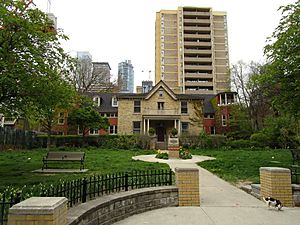
Paul Kane was one of the first Canadian painters who could make a living just from his art. He opened the way for many artists who came after him. His travels inspired others to make similar journeys. His art directly influenced F. A. Verner, who Kane mentored in his later years. According to Harper, early works by Lucius Richard O'Brien were also influenced by Kane. Kane's 1848 exhibition of his sketches, which included 155 watercolor and 85 oil on paper paintings, helped make this type of art popular. It also made it easier for artists like William Cresswell or Daniel Fowler to earn a living from their watercolor paintings.
Both his 1848 exhibition of sketches and the later 1852 show of some of his oil paintings were very successful. They were praised by several newspapers. Kane was the most important painter in Upper Canada during his time. He often entered his paintings in art exhibitions and won many awards for his work. He was the top artist throughout the 1850s. In 1852, an art jury almost apologized when they didn't give him the prize for historical paintings at the Upper Canada Agricultural Society's annual exhibition. (Kane won that prize every year until 1859, though!)
Kane was one of the first, if not the first, tourist to travel across the Canadian west and the Pacific northwest. Through his sketches and paintings, and later his book, people in Upper Canada and Lower Canada got their first look at the people and their ways of life in this huge and little-known territory. Kane had truly wanted to show his experiences accurately—the landscape, the people, their tools. Yet, it was mostly his more dramatic studio work that became popular and made him famous. His idealized oil paintings and his similarly changed travel notes (which became his book) both helped create and spread the idea of North American Indigenous people as "noble savages." This was different from what the artist had intended. His more truthful field sketches were "rediscovered" and valued by more people only in the twentieth century.
In 1937, Kane was named a National Historic Person. A plaque to remember him was put up in Rocky Mountain House in 1952.
On August 11, 1971, the year of the 100th anniversary of Kane's death, Canada Post issued a postage stamp called 'Paul Kane, painter'. It was designed by William Rueter and based on Kane's painting "Indian Encampment on Lake Huron." The 7¢ stamps had 12.5 perforation and were printed by the British American Bank Note Company.
In 1978, the City of Toronto bought the old Paul Kane House, where Kane and his family had lived. The building was later protected as a heritage structure under the Ontario Heritage Act. In 1985, the building was fixed up, and the front yard was turned into a small park.
Paul Kane High School in St. Albert, Alberta was named after Kane. A park in the Oliver neighborhood of Edmonton was also named after him.
See also
 In Spanish: Paul Kane para niños
In Spanish: Paul Kane para niños
- Elbridge Ayer Burbank
- George Catlin
- Seth and Mary Eastman
- W. Langdon Kihn
- Charles Bird King
- Joseph Henry Sharp
- John Mix Stanley


